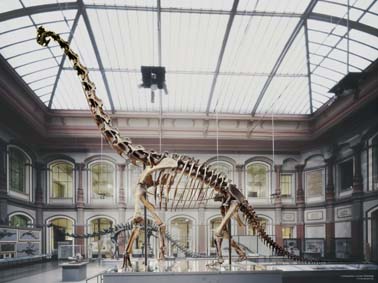- Brachiosauridae
Taxobox
name = Brachiosaurids
fossil_range =Jurassic -Cretaceous

image_width = 230px
image_caption = Mounted skeleton of "Brachiosaurus " in Berlin.
regnum =Animal ia
phylum = Chordata
classis = Sauropsida
ordo =Saurischia
subordo =Sauropodomorpha
infraordo =Sauropoda
unranked_familia =Macronaria
familia = Brachiosauridae
familia_authority = Riggs, 1904
subdivision_ranks = Genera
subdivision =
*"Astrodon "
*?"Bothriospondylus "
*"Brachiosaurus "
*"Cedarosaurus "
*?"Daanosaurus "
*?"Ischyrosaurus "
*?"Lapparentosaurus "
*"Lusotitan "
*?"Paluxysaurus "
*?"Pelorosaurus "
*?"Pleurocoelus "
*"Sauroposeidon "Brachiosauridae are a family of
dinosaur s, whose members are known as brachiosaurids. They were herbivorousquadruped s with longer forelegs than hind legs - the name derives from the Greek for "arm lizard" - and long, 45-degree angle necks. Despite their apparently distinctive features, there is some dispute as to whether Brachiosauridae is really a distinct family or a collection of basalTitanosauriformes . As a result, there is also some dispute about which animals belong within this family.Their masses would have ranged from 20 to 90 tonnes, and their unusually long and upright necks gave them access to the leaves of treetops that would have been inaccessible to othersauropod s. Their long and spatulate (spoon-shaped) teeth were capable of processing tougher plant material than some other sauropods (such as "Diplodocus "). Somepalaeontologist s had speculated that if they could have reared upon their hind-limbs even higher branches could be reached. However, their short tail and hind-limbs would have placed the creaturescentre of gravity quite far forward, and made such an action difficult.Brachiosaurids existed until at least the late
Campanian era (71-83 mya), ascaudal vertebra e from that era have been found inMexico .Kirkland, J. I.; Agullion-Martinez, M. C.; Hernandez-Rivera, R.; Tidwell, R. 2000. "A late Campanian brachiosaurid proximal caudal vertebra from Coahuila, Mexico: evidence against a Cretaceous North American sauropod hiatus". "Journal of Vertebrate Paleontology" 20 (supplement to Number 3), Abstracts of Papers, Sixtieth Annual Meeting, pp. 51A–52A.] Brachiosaurid fossils were first found inAfrica in the early20th Century , and are now known to have existed inEurope andNorth America . The first evidence of brachiosaurids inAsia was recovered in 2001,cite journal|title=The first discovery of a brachiosaurid from the Asian continent|author=Lim, J.-D.|coauthors=Martin, L.D.; Baek, K.-S.|journal=Naturwissenschaften|volume=88|issue=2|pages=82–84|doi=10.1007/s001140000201|publisher=Springer Berlin|year=2001|month=March] although the find consisted only of a few teeth.The largest mounted skeleton in the world is a brachiosaurid; the "
Brachiosaurus " at theHumboldt Museum inBerlin ,Germany .References
*http://www.users.qwest.net/~jstweet1/brachiosauridae.htm
*http://leute.server.de/frankmuster/B/Brachiosauridae.htm (in German)
*http://www.palaeos.com/Vertebrates/Units/Unit330/330.400.html#Brachiosauridae
Wikimedia Foundation. 2010.
